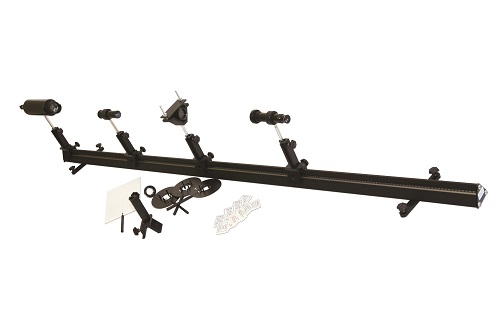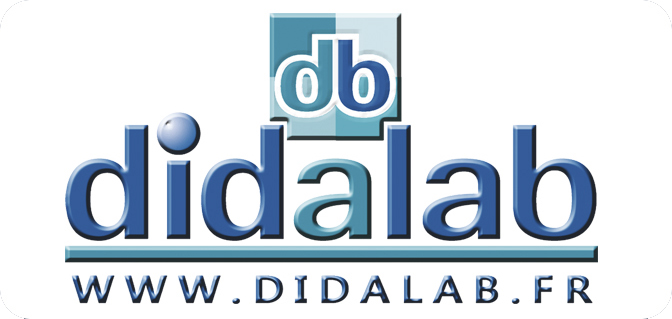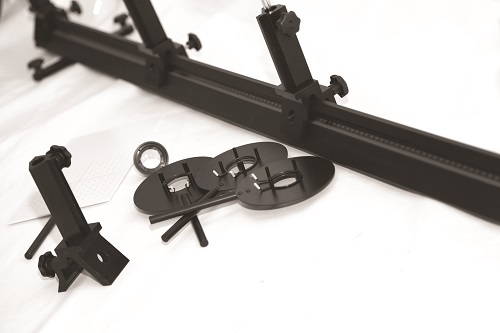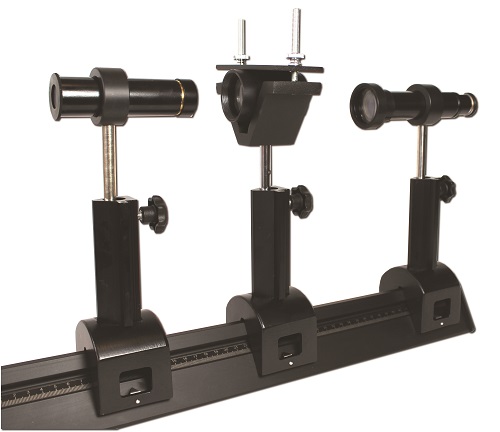The lens law : EXP200010 or EXP200011
Référence : EXP 200 010

This comprehensive optical pack will allow you to implement the main methods for studying geometrical optics. You can determine focal distances and nodal planes for convergent and divergent lenses, mirrors and thick devices.
Use of standard optical systems, such as ocular lenses or collimators, will allow you to perform the various measurements and familiarise yourself with basic optical instruments, which you will then use in future experiments.
BESSEL'S METHOD
Bessel’s method is used to determine the focal length of a converging thin lens. This method consists in imposing a distance D between an object A (for example, via a letter fixed to the lantern) and a screen E and in searching for the two positionsof the lens giving a sharp image of A on screen E. The difference between these two positions represents the distance d. Bymeasuring distances d and D, the lens focal distance is calculated.
USING A FIX FRONTAL OCULAR LENS
Above all, the telescopic sight must be set at infinity (for example, by looking at a far-off object through the window). Once set, it allows the collimator to be adjusted. The latter acts as an object. By means of an additional lens (eye piece), affixed to the lens of the ocular lens, the latter becomes a fixed frontal sighting device. Then place a diverging lens in front of the collimator and target the lens (previously marked with a felt-tip pen) using the sighting device, as well as the sight image via the lens. These two measurements provide the focal length of the lens.
CORNU'S METHOD
Two lenses are chosen to be placed in the thick system. A collimator (set to infinity) is aligned on the bench, together with the thick system to be studied and a fixed front sighting device. 3 items are targeted in turn : the reticle
image, and the input and output surface of the thick system (identified by two distinct marks on each system surface). The thick system is overturned and the 3 measurements are repeated : the reticle image and the system input and output surface. The focal distance of the thick system is calculated by applying Newton’s equations (the product of the distances of two conjugate points from the respective principal foci of a lens or mirror is equal to the square of the focal length).
SUBJECTS APPROACHED
»»Bessel’s method
»»Autocollimation method
»»Silbermann’s method
»»Badal’s method
»»Conjugate points method
»»Using a fixed frontal ocular lens
»»Cornu’s method
NECESSARY EQUIPMENT
COMPOSITION
EXP200011 Lens Law (BASIC)
| Reference | Description | quantity | | POF010110 | Prismatic optical bench, 2 m | 1 | | DPO020100 | Led lantern, with frosted glass and "d" object | 1 | | POF010124 | Optical rider | 5 | | POD010090 | Component holder, Ø 40 mm | 3 | | POD010002 | Millimetric metal screen | 1 | | POD069380 | Basic collimator | 1 | | POD069400 | Basic telescope | 1 | | POD069411 | Eye piece, +100 mm | 1 | | POD010511 | Set of 8 optical components (lenses and mirrors) | 1 | | POD608605 | Lens, Ø 40 mm, f= +250mm | 2 |
COMPOSITION
EXP200010 Lens Law (COMPLETE)
| Reference | Description | quantity | | POF010110 | Prismatic optical bench, 2 m | 1 | | DPO020100 | Led lantern, with frosted glass and "d" object | 1 | | POF010124 | Optical rider | 5 | | POD010090 | Component holder, Ø 40 mm | 3 | | POD010002 | Millimetric metal screen | 1 | | POD069380 | Basic collimator | 1 | | POD069400 | Basic telescope | 1 | | POD069411 | Eye piece, +100 mm | 1 | | POD069412 | Eye piece, +200 mm | 1 | | POD060500 | Holder for thick device | 1 | | POD061260 | Thick device | 1 | | POD010511 | Set of 8 optical components (lenses and mirrors) | 1 | | POD608605 | Lens, Ø 40 mm, f= +250mm | 2 |
|
|




